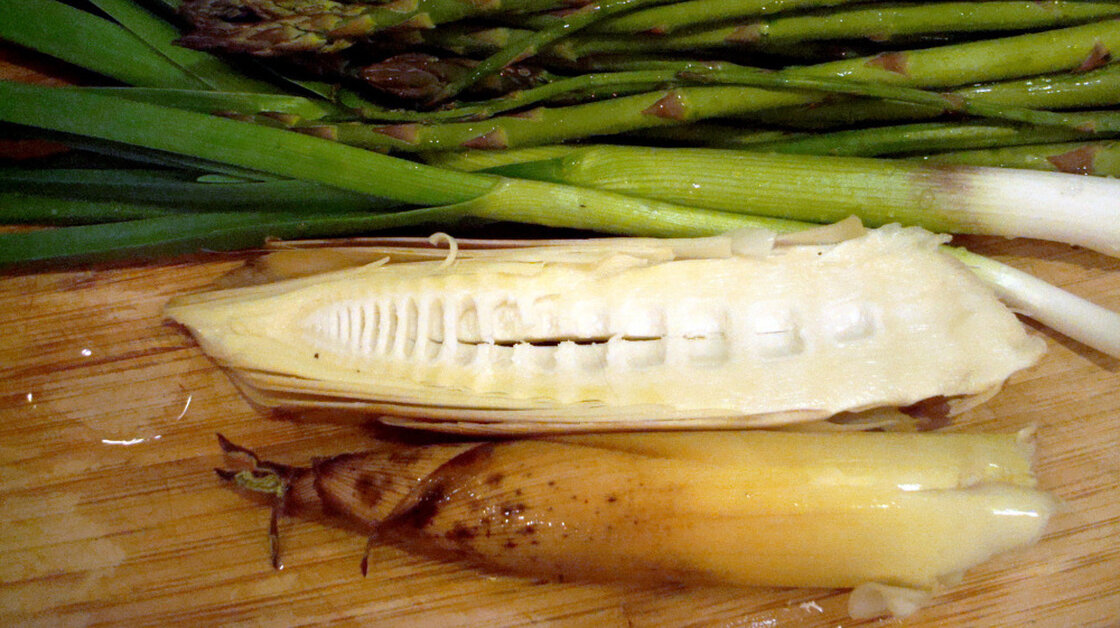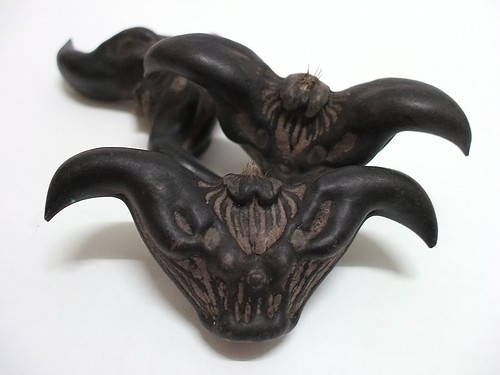Always intrigued by new cuisines and new ingredients, we stopped to buy some vegetables that I have not knowingly eaten prior to now. Outside of the Buddhist temple that abuts Nanguan Park, which is a stone's throw from where we live, a man was selling these interesting-looking vegetables.
 |
| Water Caltrops for Sale Photo credit: Deborah Zhang (c) 2013 |
Wikipedia says of these:
The water caltrop, water chestnut, buffalo nut, bat nut, devil pod, Singhara (Hindi: सिंघाडा)سنگھارا (Urdu) or Pani-fol (Hindi: पानीफल) is any of three extant species of the genus Trapa: Trapa natans, T. bicornis and the endangered Trapa rossica. The species are floating annual aquatic plants, growing in slow-moving water up to 5 meters deep, native to warm temperate parts of Eurasia and Africa. They bear ornately shaped fruits, which in the case of T. bicornis resemble the head of a bull, each fruit containing a single very large starchy seed. T. natans and T. bicornis have been cultivated in China and India for at least 3,000 years for the edible seeds.
While I have eaten water chestnuts previously--mostly in American Chinese food--I have never seen anything like these. They are beautiful and as the Wikipedia entry states, positively bovine in their appearance with a hint of orchidness. Georgia O'Keefe would have had a field day painting them!
I just cooked four of them as a sample. They are delicious, but nearly impenetrable.
Chef-A-Gogo describes his experience with these popular tidbits when he was introduced to them in Phuket, Thailand. He explains that they are not crunchy like a water-chestnut, but much more like an actual chestnut--you know, the kind that December's carolers sing about roasting on an open fire.
 |
| Chinese Nutpick with Mother-of-pearl handle |
As we do not have a nutpick, we are using our tea awl to dig out the meat.
Wikipedia continues,
Water caltrop has been an important food for worship as prayer offerings since the Chinese Zhou Dynasty. The Rites of Zhou (2nd century BC) mentioned that a worshipper "should use a bamboo basket containing dried water caltrops, the seeds of Euryale ferox and chestnuts" (加籩之實,菱芡栗脯). The Chinese Herbal Medicine Summary (本草備要 published in 1694, written by Wang Ang 汪昂) indicates that water caltrop can help fever and drunkenness.
As you can see from the first picture above, our street vendor was also selling chestnuts, which are for sale everywhere in the streets of Beijing, much as sweet potatoes are, as well. He was not selling the water lily seeds of
Eurayle ferox, though. These, I am quite sure, I have never seen.
I bought a ¥10 bag of the mountain yam bean. It weighs about 2 kg and will do nicely for a couple of yummy dinners. Now I must set about how to prepare them. It is not easy sometimes to find recipes.
On Sunday morning, we had brunch at a spicy fish hot-pot place with an old colleague of mine from the High School Attached to Northeast Normal University and she and her husband ordered something which the Chinese-English dictionary calls "asparagus", but is really bamboo shoots.
NPR has a wonderful story about the kind of "asparagus" that I am trying to identify for you.
 |
| Photo credit: Laura McCandlish for NPR |






No comments:
Post a Comment
You are encouraged to leave your two cents.